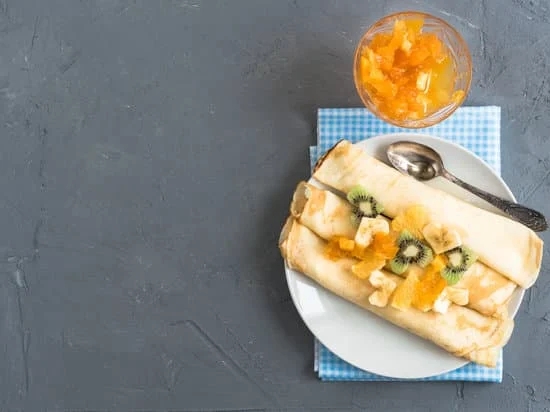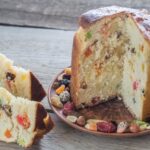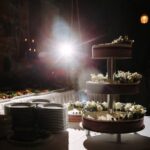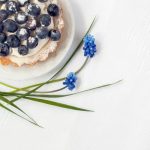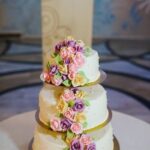Cake decoration is not just about making a dessert look pretty; it is an art form that can elevate the taste and visual appeal of a cake. Whether it’s a simple birthday cake or an elaborate wedding cake, the way it is decorated can make all the difference in its overall presentation. So, what do you decorate cakes with to achieve those stunning designs that leave everyone in awe?
One of the most popular cake decorating materials is fondant. Fondant offers decorators a smooth and versatile canvas to create intricate designs. Its pliable texture allows for endless possibilities, from sculpting whimsical figures to crafting elegant floral patterns. Another favorite among bakers is buttercream frosting, loved for its creamy texture and ability to be piped into various designs. Buttercream not only adds sweetness but also acts as a delicious filling between cake layers.
For those looking to create delicate and detailed decorations, royal icing is the go-to choice. This icing hardens when dried, making it perfect for creating intricate designs like lace patterns and flowers on cakes. And let’s not forget about edible decorations like sprinkles, edible flowers, and edible glitter that can add color and texture to any dessert masterpiece. With these essential tools and materials at your disposal, the world of cake decorating is yours to explore and conquer.
Fondant
There are different types of fondant available in the market, including rolled fondant and modeling chocolate. Rolled fondant is commonly used for covering cakes entirely due to its smooth texture and ability to hold its shape well. On the other hand, modeling chocolate is preferred for creating figurines, flowers, and other detailed decorations on cakes. Both varieties allow decorators to unleash their creativity and bring their cake designs to life.
When it comes to using fondant for cake decoration, the possibilities are endless. From creating realistic flower petals and intricate lace patterns to sculpting 3D characters and structures, fondant offers decorators endless opportunities to showcase their artistic skills. Here are some popular techniques used with fondant in cake decoration:
- Covering an entire cake with rolled fondant for a smooth finish
- Creating figurines or sculpted decorations using modeling chocolate
- Using molds or cutters to make precise shapes like stars or hearts
Buttercream Frosting
When it comes to piping designs on cakes, buttercream frosting is a go-to option for many bakers because of its ability to hold shapes well. Whether you are looking to create intricate flowers, elegant swirls, or fun borders, buttercream frosting can be easily manipulated through different piping techniques. Some popular piping designs include rosettes, which add a touch of elegance to any cake, ruffles for a whimsical look, and borders that can frame the edges of a cake beautifully.
In addition to its aesthetic appeal, buttercream frosting also provides a deliciously sweet flavor that complements the cake layers perfectly. The smoothness of buttercream frosting adds an extra layer of richness to every bite of cake.
Whether you’re going for a simple and classic look or aiming for more elaborate decorations, buttercream frosting is a versatile option that allows you to unleash your creativity in cake decorating. So when wondering what do you decorate cakes with, consider using buttercream frosting for all your decorative needs.
Royal Icing
Hardening Capability
One of the key advantages of using royal icing for cake decoration is its ability to harden completely once dried. This feature allows decorators to create three-dimensional elements that can stand upright on the surface of a cake or be used for decorative purposes without fear of collapsing or smudging. From delicate roses to intricate filigree patterns, royal icing provides decorators with the flexibility to bring their creative visions to life with confidence.
Perfect for Intricate Designs
The fine consistency of royal icing lends itself well to detailed designs that require precision and accuracy. Cake decorators often use this versatile medium to create lace patterns that mimic intricate embroidery or delicate floral arrangements that add elegance and sophistication to their creations. Whether it’s replicating lace details on a wedding cake or crafting edible jewels for a themed celebration, royal icing offers limitless opportunities for creating stunning works of art on cakes.
In addition to its functional properties, royal icing is also prized for its pure white color when dried, making it an excellent choice for achieving crisp lines and clean finishes on cakes. Whether used as a stand-alone decoration or in combination with other techniques like fondant or buttercream frosting, royal icing continues to be a beloved medium for experienced bakers and novice decorators alike looking to elevate their cake designs with precision and finesse.
Edible Decorations
Sprinkles: Adding Fun and Color
Sprinkles are perhaps one of the most popular edible decorations used on cakes. They come in various shapes, sizes, and colors, allowing decorators to create unique designs or add a pop of color.
From classic rainbow sprinkles to metallic dragees, sprinkles can be scattered on top of cakes for a festive look or used strategically to create patterns and designs. Whether you prefer the simplicity of traditional jimmies or the elegance of sugar pearls, sprinkles offer an easy way to add fun and flavor to your cakes.
Edible Flowers: Bringing Nature’s Beauty
Edible flowers are another stunning option for decorating cakes. These delicate blooms not only add a touch of natural beauty but also infuse floral flavors into the cake. Edible flowers like roses, violets, pansies, and lavender can be used fresh or crystallized as decorations.
They can be placed elegantly on top of cakes as a focal point or scattered around for a romantic garden-inspired look. Edible flowers are not only visually appealing but also aromatic, adding an extra layer of sophistication to your cake creations.
Edible Glitter: Adding Sparkle and Shine
For those looking to bring some glitz and glamor to their cakes, edible glitter is the perfect choice. Edible glitter comes in various shades and sizes, from fine shimmer dust to chunky glitter flakes. It can be dusted lightly over cakes for a subtle sparkle or applied more generously for a dazzling effect.
Whether you want a glamorous metallic finish or a whimsical rainbow sparkle, edible glitter adds that extra touch of magic to your cake design. Just remember that when using edible glitter less is often more – so sprinkle sparingly for an enchanting touch.
Piping Techniques
Another classic piping technique is the creation of ruffles on cakes. Ruffles add a touch of elegance and whimsy to any cake design, giving it a soft and delicate appearance. To make ruffles, decorators typically pipe small lines of frosting in a slightly overlapping pattern, creating a textured effect that mimics fabric or frills. Ruffles can be used to embellish tiers on wedding cakes, dress up birthday cakes, or add depth to floral arrangements on celebration cakes.
Borders are another versatile piping technique that can enhance the overall look of a cake by framing the edges or layers with decorative patterns. Borders can be simple straight lines, scalloped designs, or intricate lace-like patterns, depending on the desired aesthetic.
Using different piping tips and techniques, bakers can customize borders to complement the theme of the cake, whether it’s rustic and simple or elegant and elaborate. Borders not only provide a finishing touch to a cake but also help define its structure and presentation.
| Piping Techniques | Data |
|---|---|
| Rosettes | Swirls of frosting resembling rose petals; used for decorating cupcakes or borders |
| Ruffles | Create an elegant and delicate textured effect on cakes; mimic fabric or frills |
| Borders | Enhance the overall look of a cake by framing edges with decorative patterns; from simple lines to intricate lace designs |
Tools and Equipment
When it comes to decorating cakes, having the right tools and equipment is essential to achieve professional-looking results. Piping bags are a must-have tool for cake decorators, as they allow for precise application of frosting, royal icing, or buttercream.
These disposable or reusable bags come in various sizes and materials to suit different decorating needs. Coupled with piping tips, which come in an array of shapes and sizes, decorators can create intricate designs such as flowers, borders, and lettering on cakes.
For working with fondant decorations on cakes, fondant smoothers are indispensable. These flat tools help achieve a smooth finish when covering cakes with fondant and also assist in creating sharp edges and clean lines. Edible markers are another handy tool for adding personalized messages or intricate details to cakes. These markers come in a range of colors and tip thicknesses, allowing decorators to write directly on fondant or edible images.
In addition to these basic tools, cake decorators may also find edible glitter and luster dust useful for adding shimmer and sparkle to their creations. Edible glitter comes in various colors and adds a touch of glamour to cakes for special occasions like birthdays or weddings.
Luster dust, on the other hand, is used to create a metallic or pearlescent sheen on fondant decorations or painted designs on cakes. With the right tools at their disposal, cake decorators can unleash their creativity and elevate their cake designs to new heights.
| Tools | Function |
|---|---|
| Piping Bags | For precise application of frosting |
| Fondant Smoothers | To achieve smooth finish when covering cakes with fondants |
| Edible Markers | For adding personalized messages or intricate details to cakes. |
Advanced Decorating Techniques
Advanced cake decorating techniques offer a whole new level of creativity and artistry to elevate the appearance of cakes. One popular advanced technique is sculpting with fondant. Fondant can be molded and shaped into various intricate designs, allowing for the creation of 3D elements like figures, flowers, and objects. Sculpting with fondant requires precision and patience but opens up endless possibilities for unique cake decorations that add a wow factor to any celebration.
Another advanced decorating technique is painting on cakes. This technique involves using edible food coloring or food paints to create detailed designs directly on the surface of the cake. From delicate watercolor effects to bold patterns and intricate motifs, painting on cakes allows decorators to showcase their artistic skills and add personalized touches to their creations. With practice and a steady hand, painters can achieve stunning works of edible art that are sure to impress both visually and gastronomically.
Using edible images is also a sophisticated way to decorate cakes. Edible images are printed designs or photographs on edible paper using food-safe ink. These images can be applied onto cakes to create customized decorations, from birthday messages to corporate logos.
The versatility of edible images makes them a popular choice for professional decorators looking to achieve precise and detailed designs without the need for intricate piping or sculpting skills. When combined with other advanced techniques like fondant sculpting or painting, edible images can enhance the overall aesthetic appeal of a cake while providing a professional finish that wows guests and clients alike.
Conclusion
Cake decoration plays a crucial role in not only enhancing the visual appeal but also adding flavor and texture to a cake. From fondant to buttercream frosting, royal icing to edible decorations, the options are endless when it comes to decorating cakes. Each material offers its unique properties and benefits, allowing for creativity and artistry in cake decorating.
Fondant, with its smooth texture and versatility, is perfect for creating intricate designs on cakes. Buttercream frosting, on the other hand, provides a smooth base for decorating and filling cakes while offering the ability to pipe various designs with ease. Royal icing sets hard when dried, making it ideal for delicate designs like flowers and lace patterns that require precision.
In addition to these traditional cake decorating materials, edible decorations like sprinkles, edible flowers, and edible glitter add color and texture to cakes. Piping techniques such as rosettes, ruffles, and borders offer endless possibilities for creating unique designs. With the right tools and equipment such as piping bags, tips, fondant smoothers, and edible markers, aspiring decorators can bring their creative visions to life on a cake canvas.
Whether opting for simple buttercream designs or venturing into elaborate fondant creations or advanced techniques like sculpting or painting on cakes, there is no limit to what one can decorate cakes with. The only boundary is one’s imagination in the world of cake decoration.
Frequently Asked Questions
What Do You Use to Decorate Cakes?
I use a variety of tools to decorate cakes, including piping bags, various piping tips for different designs, fondant shaping tools, offset spatulas for smoothing icing, and edible decorations like sprinkles or edible pearls.
What Are the 5 Kinds of Cake Decorating?
The five kinds of cake decorating techniques include piping (using buttercream or royal icing to create intricate designs), fondant decoration (covering the cake with smooth fondant and creating 3D decorations), buttercream flowers (creating realistic flowers using buttercream), royal icing details (intricate piped designs using stiff royal icing), and cake stenciling (using stencils to add intricate designs with powdered sugar or food spray).
What Kind of Icing Is Best for Decorating Cakes?
The best kind of icing for decorating cakes depends on the design you want to achieve. Buttercream is great for piping detailed designs and creating textured finishes. Fondant provides a smooth canvas for elaborate decorations and sculpting 3D elements.
Royal icing is perfect for intricate piped details and creating delicate borders. Ganache is excellent for achieving a shiny finish or creating sharp edges on a cake. Ultimately, the best icing for decorating cakes is the one that suits your desired look and skill level.

Welcome to our cake decorating blog! My name is Destiny Flores, and I am the proud owner of a cake decorating business named Cake Karma. Our mission is to provide delicious, beautiful cakes for all occasions. We specialize in creating custom cakes that are tailored specifically to each customer’s individual needs and tastes.

